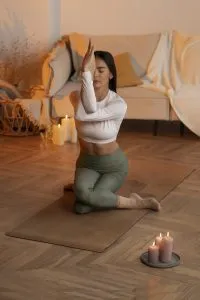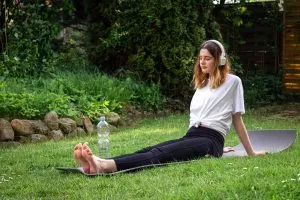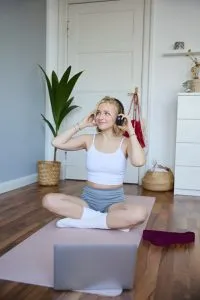Introduction – The Yoga Mat Necessity Dilemma
Picture this: You’re about to start your morning yoga routine. You unroll your yoga mat, take a deep breath, and feel the familiar texture beneath your feet. But have you ever wondered if you really need that yoga mat? Is it a necessity, or could you practice yoga without it? Let’s dive into the world of mat-free yoga practice and explore the true necessity of a yoga mat. 
The Origins of the Yoga Mat
Before we delve into the benefits and alternatives, let’s take a quick trip down memory lane. The modern yoga mat, as we know it, was invented by Angela Farmer in the 1960s. Angela, a yoga teacher, found that her hands and feet would slip during practice due to a medical condition. She improvised by using a piece of carpet underlay, which provided the grip and stability she needed. This simple innovation revolutionized yoga practice and led to the commercial production of yoga mats.
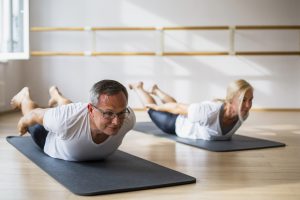
The Benefits of Yoga Mats
Cushioning and Support
One of the primary benefits of a yoga mat is the cushioning it provides. Whether you’re in child’s pose or transitioning into a headstand, the mat offers a protective barrier between your body and the hard floor. This cushioning helps absorb shock and reduce stress on your joints, making your practice more comfortable and safer.
Stability and Grip
A yoga mat’s textured surface provides essential traction, preventing slips and falls during poses. This is especially important for poses like downward dog and warrior, where stability is key. The mat’s grip allows you to focus on your alignment and breath without worrying about slipping.
Hygiene
Practicing on a personal yoga mat ensures a clean and hygienic surface. Public spaces and shared mats can harbor germs and bacteria, but your own mat can be easily cleaned and disinfected. This reduces the risk of skin infections and illnesses, giving you peace of mind during your practice.
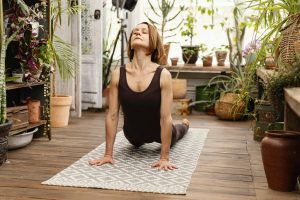
Exploring Mat-Free Yoga Practice
The Appeal of Mat-Free Yoga
Mat-free yoga practice has been gaining popularity among yogis who seek a more natural and grounded experience. Practicing without a mat can enhance your connection to the earth and improve your balance and stability. It encourages you to engage your muscles more actively, as you rely on your body’s strength to maintain poses.
Benefits of Mat-Free Yoga Practice
- Enhanced Strength and Stability: Practicing on natural surfaces like grass, sand, or even a blanket can challenge your balance and stability. This can lead to improved muscle engagement and strength development.
- Increased Mindfulness: Without the defined boundaries of a mat, you become more aware of your body’s movements and alignment. This heightened mindfulness can deepen your practice and enhance your focus.
- Connection to Nature: Practicing yoga outdoors, directly on the ground, allows you to connect with nature. The feeling of grass beneath your feet or the sound of waves crashing nearby can create a serene and grounding experience.
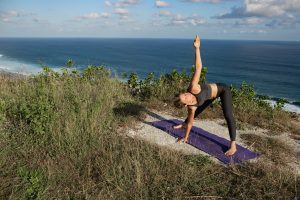
Yoga Without a Mat – Practical Tips
Choosing the Right Surface
If you’re considering mat-free yoga practice, it’s important to choose the right surface. Grass, sand, and even a soft carpet can provide a comfortable and stable base for your practice. Avoid hard or uneven surfaces that could cause discomfort or injury.
Modifying Your Practice
Without the cushioning of a mat, you may need to modify certain poses to ensure comfort and safety. For example, using a folded blanket or towel under your knees in poses like camel or cat-cow can provide extra support.
Listening to Your Body
As with any yoga practice, it’s crucial to listen to your body and honor its limits. If you find that practicing without a mat causes discomfort or strain, consider incorporating a mat or other supportive props into your routine.

FAQs – Common Questions About Yoga Mat Necessity
1. Is a yoga mat necessary for beginners?
While a yoga mat can provide valuable support and stability for beginners, it’s not strictly necessary. Beginners can practice on soft surfaces like grass or carpet, but should be mindful of their alignment and comfort.
2. Can I practice yoga on a towel or blanket instead of a mat?
Yes, a towel or blanket can be used as an alternative to a yoga mat. However, they may not provide the same level of grip and stability, so be cautious with poses that require balance.
3. What are the benefits of practicing yoga without a mat?
Practicing yoga without a mat can enhance your strength, stability, and mindfulness. It allows you to connect more deeply with the earth and can create a more natural and grounding experience.
4. Are there any drawbacks to practicing yoga without a mat?
The main drawbacks of practicing without a mat are the lack of cushioning and grip. This can make certain poses more challenging and may increase the risk of discomfort or injury.
5. How do I clean and maintain my yoga mat?
To clean your yoga mat, use a mixture of water and mild soap or a specialized yoga mat cleaner. Wipe down the mat with a damp cloth and allow it to air dry. Regular cleaning helps maintain hygiene and prolong the life of your mat.
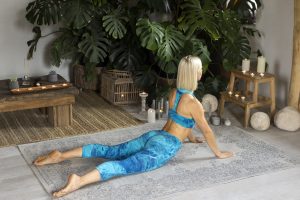
Conclusion – Finding Your Yoga Practice
In the end, whether you choose to use a yoga mat or practice mat-free is a personal decision. Both options have their unique benefits and can enhance your yoga journey in different ways. The key is to find what works best for you and supports your practice.
Call-to-Action – Explore Your Yoga Practice
Ready to explore your yoga practice further? Whether you’re a seasoned yogi or just starting out, finding the right tools and techniques can make all the difference. Consider trying a mat-free practice to see how it feels or invest in a high-quality yoga mat that meets your needs. Remember, yoga is about finding balance and connection, both on and off the mat.
Happy practicing! 🧘♀️🧘♂️

